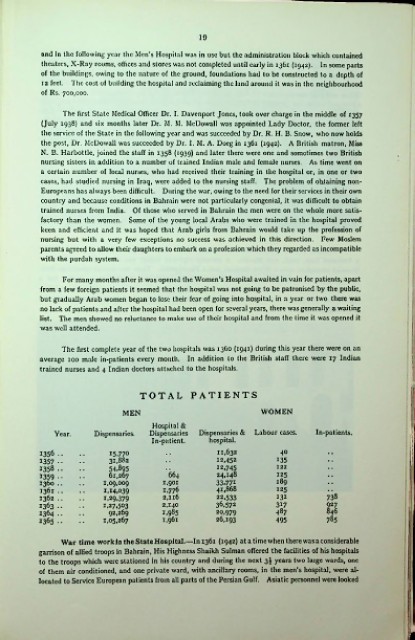Page 287 - Bahrain Gov Annual Reports (III)_Neat
P. 287
19
and in the following year the Men's Hospital was in use but the administration block which contained
theatres, X-Ray rooms, offices and stores was not completed until early in 1361 (1942). In some parts
of the buildings, owing to the nature of the ground, foundations had to be constructed to a depth of
12 feet. The cost of building the hospital and reclaiming the land around it was in the neighbourhood
of Rs. 700,000.
The first State Medical Officer Dr. I. Davenport Jones, took over charge in the middle of 1357
(July 1938) and six months later Dr. M. M. McDowall was appointed Lady Doctor, the former left
the service of the State in the following year and was succeeded by Dr. R. H. B. Snow, who now holds
the post, Dr. McDowall was succeeded by Dr. I. M. A. Doeg in 1361 (1942). A British matron, Miss
N. B. Harbottle, joined the staff in 1358 (1939) and later there were one and sometimes two British
nursing sisters in addition to a number of trained Indian male and female nurses. As time went on
a certain number of local nurses, who had received their training in the hospital or, in one or two
cases, had studied nursing in Iraq, were added to the nursing staff. The problem of obtaining non-
Europeans has always been difficult. During the war, owing to the need for their services in their own
country and because conditions in Bahrain were not particularly congenial, it was difficult to obtain
trained nurses from India. Of those who served in Bahrain the men were on the whole more satis
factory than the women. Some of the young local Arabs who were trained in the hospital proved
keen and efficient and it was hoped that Arab girls from Bahrain would take up the profession of
nursing but with a very few exceptions no success was achieved in this direction. Few Moslem
parents agreed to allow their daughters to embark on a profession which they regarded as incompatible
with the purdah system.
For many months after it was opened the Women’s Hospital awaited in vain for patients, apart
from a few foreign patients it seemed that the hospital was not going to be patronised by the public,
but gradually Arab women began to lose their fear of going into hospital, in a year or two there was
no lack of patients and after the hospital had been open for several years, there was generally a waiting
list. The men showed no reluctance to make use of their hospital and from the time it was opened it
was well attended.
The first complete year of the two hospitals was 1360 (1941) during this year there were on an
average 100 male in-patients every month. In addition to the British staff there were 17 Indian
trained nurses and 4 Indian doctors attached to the hospitals.
i.
TOTAL PATIENTS
MEN WOMEN
Hospital &
Year. Dispensaries. Dispensaries Dispensaries & Labour cases. In-patients.
In-patient. hospital.
1356 . • 15.770 11,632 40
1357 • • 31,882 12.452 135
1358 .. 54.895 12,745 121
1359 • • 61,267 664 24,148 125
1360 .. 1,09,009 1.901 33.771 189
1361 .. I.I4.039 1,776 41,868 125
1362 .. 1.29.379 2,116 22.533 131 738
1363 • • 1.27.503 2,140 36,572 317 927
1364 • • 92,269 1.985 20,979 487 846
1365 • • 1,05,267 1,961 26,193 495 7S5
War time work in the State Hospital.—In 1361 (1942) at a time when there was a considerable
garrison of allied troops in Bahrain, His Highness Shaikh Sulman offered the facilities of his hospitals
to the troops which were stationed in his country and during the next 3$ years two large wards, one
of them air conditioned, and one private ward, with ancillary rooms, in the men's hospital, were al
located to Service European patients from all parts of the Persian Gulf. Asiatic personnel were looked
1

